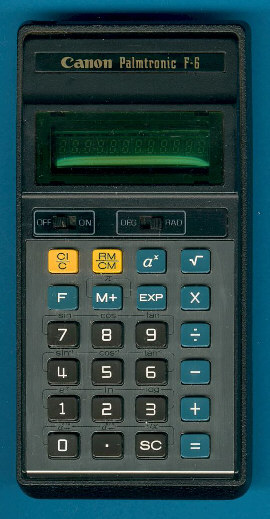
DATAMATH CALCULATOR MUSEUM
 |
DATAMATH CALCULATOR MUSEUM |
Canon F-6
| Date of introduction: | 1975 | Display technology: | Fluorescent |
| New price: | Display size: | 8 | |
| Size: | 6.5" x
3.3" x 1.25" 164 x 84 x 32 mm3 |
||
| Weight: | 6.2 ounces, 176 grams | Serial No: | 517382 |
| Batteries: | 3*AA | Date of manufacture: | year 1975 |
| AC-Adapter: | AD-1 | Origin of manufacture: | Japan |
| Precision: | 8 | Integrated circuits: | Hitachi HD3699 |
| Memories: | 1 | ||
| Program steps: | Courtesy of: | Joerg Woerner |
 The
Palmtronic F-6 continued the scientific line of calculators sold by Canon. It is
the direct successor of the F-5 and uses again a "TI-less" calculator
brain. The major design in the housing was continued with calculators like the F-2,
LD-10M, Palmtronic F-31
and LC-8M.
The
Palmtronic F-6 continued the scientific line of calculators sold by Canon. It is
the direct successor of the F-5 and uses again a "TI-less" calculator
brain. The major design in the housing was continued with calculators like the F-2,
LD-10M, Palmtronic F-31
and LC-8M.
The top of the scientific calculators sold mid of the 1970's was the desktop series Canola F-10 and Canola F-11. Both used again a calculator architecture developed by Hitachi.
Later scientific calculators like the Palmtronic F-51 and Palmtronic F-71 missed again the TI brain. Don't miss the Toshiba SC-7100, a direct competitor of the F-6.
Running Mike Sebastian's "Calculator forensics" gives an unacceptable bad result of 12.199423 instead the expected value close to 9.0000. But even Texas Instruments failed one time with their algorithm, don't miss the rare SR-40 prototype.
Another known side effect of the poor algorithm of the Hitachi calculator chips could be discovered with the unusual [ax] key:
Hitachi uses - like most other companies - the
equation: It is easy to proove:
|
If you have additions to the above article please email: joerg@datamath.org.
© Joerg Woerner, January 11, 2002. No reprints without written permission.